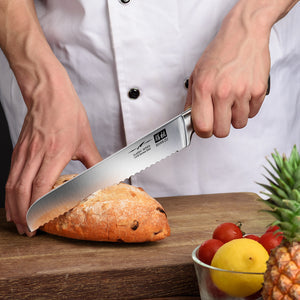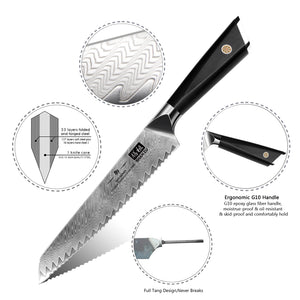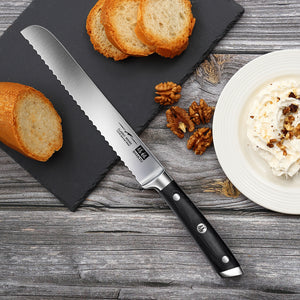
Knives come in various shapes and sizes, all serving a unique purpose in routine kitchen work.
One such type is a serrated knife. This saw-toothed knife easily cuts through tough objects and requires very little maintenance.
And as the title says, this guide is all about serrated knives and how to sharpen them!
What Is A Serrated Knife?
A serrated knife comes with a blade that has a saw-like appearance at its one end. The serrated design of the blade’s edge allows it to easily cut through tough and thick-textured materials like crusty bread loaves.
The toothed, saw-toothed design of the serrated knife gives it an edge over plain knives. Serrations allow the user to approach the tough material at sharper angles with minimum contact points. And this sharp-angled approach with minimum contact points increases the applied pressure, which ultimately causes fast and precise cuts.
Lastly, serrated knives outlast their counterparts in terms of sharpness and maintenance. And that brings us to the part.

What Causes Knives To Go Dull?
As stated earlier, serrated knives tend to stay sharp longer than plain knives. However, they can still get dull, and it can be due to any of the following reasons:
Using the knife on a glass or stone surface. Friction between the blade’s metal and stone alters the shape of serrations and can significantly lower the knives’ cutting ability.
Placing it in the dishwasher where it’s clattering around with other utensils may alter its sharpness.
Using it, or rather, abusing it for purposes other than cutting. For example, substituting the knife for a screwdriver damages the tip, causing dullness.
Can Serrated Knives Be Sharpened?
As mentioned earlier, serrated knives exert maximum pressure at lesser points of contact, which causes less friction. Hence, they usually require little maintenance in terms of sharpness.
However, they can still get dull, and there are a variety of ways to “re-sharp” them. Some of the commonly used methods include using diamonds, ceramic honing rods, electric serrated knife sharpener, motorized knife sharpeners, etc.
What Type Of Knife Sharpener Is Best For Serrated Knives?
Every serrated knife is differently serrated. One knife might feature 33 serrations other might have fewer or more. It all depends on your choice.
Now, using any of the above-mentioned serrated knife sharpener would require you to go through each serration individually. That’s why people prefer to hand over the task to professionals.
The best way to sharpen a serrated knife is by using a diamond tapered knife sharpener or an electric serrated knife sharpener, both of which are easily available to professional service providers.
What Is Sharpening Steel?
Sharpening steel is also known as honing steel, and it has multiple forms, all of which serves the same purpose that is sharpening the knife. Among its multiple forms, some are entirely made of steel, ceramic, or even diamond-coated steel.
Technically speaking, a sharpening steel is not a serrated knife sharpener. It rather serves to align the microscopic curls in the blade that may develop over time.

There Are Many Great Knife Sharpeners Available For Your Serrated Knives!
The market is over-saturated with products claiming to be the best serrated knife sharpener. And that makes it hard to decide which one would work best for you and your knife. Here’s an easy approach to that dilemma:
Prioritize ease of use when choosing a serrated knife sharpener. An electrical serrated knife sharpener is reserved for professional purposes, whereas sharpening steel would come in handy for an average household user.
How To Sharpen A Serrated Knife
Depending on your skills, any serrated knife sharpener would do the job. Moreover, there’s no automatic serrated knife sharpener. Even a motorized serrated knife sharpener requires manual handling, so there’s always a risk of harming oneself. And that’s why it’s better to hand over the task to a professional.
But for our educational purposes, let’s look at some of the ways to sharpen a serrated knife:
Tools Needed For Sharpening A Serrated Knife
First things first, what are the tools you may need to sharpen a serrated knife?
But before we get to that, it’s important to clarify that there’s no such thing as an all-in-one serrated knife sharpener.
Each tool is designed to cater to specific users and their needs. And it can range from simple sharpening steel to a complex electrical serrated knife sharpener.
3 Tips For Sharpening Serrated Knives
Serrated knives can be easily sharpened by following a simple standard of procedures (SOPs). Some things should be strictly avoided, while others count as good practice, all of which are discussed here:
- Different shapes and sizes of serrated knives require different standards of sharpening tools. So, choosing the right equipment can be a game-changer. In most cases, a standard sharpening rod can cover a wide range of serrated knives.
-
The side of the knife and the angle at which it is being sharpened play a significant role in correct SOPs.
- Only sharpen the beveled side of the serrated knife. Sharpening the other side can damage the integrity of the blade.
- To avoid damaging the serrations, follow the angle of the gullet, which is usually in the range of 10-30 degrees.
- Knife sharpening requires manual handling. And manual handling calls for safe gripping techniques. To avoid any mishap, from minor inconveniences to major accidents, a vice grip should be used to secure the knife in one position.
A Guide To Sharpening Your Serrated Bread Knives At Home
The DIY method of serrated knife sharpening involves the use of honing rods. As stated earlier, sharpening a serrated knife can be tricky because each serration on the beveled side requires individual attention.
Here’s how to use honing rod as a serrated knife sharpener all by yourself:
- Of all the varieties of sharpening rods, the ones made of diamond-coated steel give the best results, closely followed by ceramic rods.
- No matter what the constituent of your sharpening rod is, it’ll have a varying degree of thickness. The variable thickness allows the rod to accommodate different shapes and sizes of serrations.
- Find the appropriate width for your serrated knife on the honing rod. Now, place that part of the rod between the serrations and drag it.
- Maintain a 10-30 degrees angle and continue dragging the rod away from the blade. Dragging the rod away from the knife saves you from harming yourself.
- For optimum results, stroke each tightening at least 4-5 times.
- After beveled side completion, switch it over and stroke the flat edge a couple of times using a regular sharpening stone.
- Wash away the burr and promptly dry the knife. And that’s all there is to DIY serrated knife sharpening.
How To Sharpen A Serrated Knife With An Electric Sharpener
Continued use of electric serrated knife sharpener poses a risk of damaging the serrations. But there’s no denying that it makes the whole process less labor-intensive. And here’s how to use an electric serrated knife sharpener:
- Clean the blade and determine the stage of the electric sharpener you want to work at. Usually, setting it to a fine stage is enough to properly hone the blade.
-
Once you’ve selected a particular stage on the sharpener, run the blade through it four times in the following manner:
- While holding it down, pass the blade from the heel of the knife to its tip. Make sure that the serrations are in contact with the wheel of the sharpener. Run through both sides of the serration.
- Repeat the process if the knife hasn’t reached the desired level of sharpness. However, if the sharpness meets your expectations, halt the process, and rinse the knife with water before use.
- That’s it. Your serrated knife is now good as new.
Frequently Asked Questions
1. Can I Sharpen A Serrated Slicer Or Serrated Electric Knife?
Serrated slicer, or the electric version of serrated knives, can be sharpened using the same techniques as mentioned above.
A serrated electric knife should be separated from the power source. And then, the handle and the blade should be removed from the motor and sharpened accordingly.
2. How Can I Sharpen A Serrated Knife Without Any Special Tools?
The complex design of serrated knives demands the use of special tools like honing rods. Despite that, serrated knives can still be sharpened using something as ordinary as an old coffee mug.
The bottom depression of the cup and the surrounding rim together serves as an excellent knife sharpener. Its mechanics are similar to sharpening rods: the serration is placed at the rough bottom and stroked at least 5 times to ensure proper sharpness.
3 What Other Steps Can I Take To Ensure My Serrated Knife Stays Sharp As Long As Possible?
Serrated knives already have a longer lifespan than flat-edged knives. Their longevity can be further extended by avoiding bad knife practices mentioned in the article. For example, it shouldn’t be placed in the dishwasher with other items.
Frequent exposure to water should also be avoided at all costs. And the knife mustn’t be used for purposes other than cutting.
Lastly, the blade gets weakened and dull after every fall, so a magnetic knife holder might come in handy.
4. Should You Use An Electric Knife Sharpener To Sharpen A Serrated Blade?
The blades of a serrated knife do get damaged if they’re frequently sharpened using electric sharpeners. Moreover, the serrations might break or assume an uneven shape. Increased burr or metal wastage also weakens the blade.
Ideally, serrated knives should only be sharpened once they have the peak of their dullness. Even then, it’d be better to use a sharpening rod instead of an electric serrated knife sharpener.
5. Can I Use A Whetstone To Sharpen My Serrated Knife?
Whetstone offers one of the easiest ways to sharpen serrated knives. But the whole process is very time-consuming and labor-intensive.Its mechanics is more or less similar to a sharpening rod.
6. Can You Make A Cheap Serrated Knife Sharp?
As the name suggests, cheap serrated knives are made by compromising the quality of the blade. Now, electric knife sharpeners already have a damaging effect on the integrity of the blade. A cheaper version of it won’t survive repeated exposure to sharpening tools.
7. What Is A Serrated Knife Good For?
Serrated knives are good at cutting through tough objects. In the kitchen, they are used to make fast and precise cuts on crusty bread loaves, tomatoes, and big chunks of meat. A general rule of thumb is that serrated knives are good for cutting through objects that have a tough exterior and a smooth interior.
8. Is A Serrated Knife Better For Self-Defense?
Their usability as a self-defense object is debatable. Although it makes a serious wound, experts argue that it may get stuck in the clothing of the attacker rendering it useless.
On the other side, the serrated knife can easily cut through jackets or any other tough material. In short, serrated knives are only effective if you can get them past the clothing and stab directly on the exposed flesh.

Conclusion
Serrated knives are a must-have kitchen item if you want to ease the cutting aspect of cooking. The serrations allow it to cut through tough objects faster with unmatched precision. The knife is also low on maintenance and usually outperforms the flat-edged knives in terms of sharpness, longevity, and much more!
In the long run, even serrated knives could use some sharpening. And there are tons of techniques available out there, ranging from DIY methods to professional services. Using the sharpening rod technique is labor-intensive but preserves the integrity of the blade. But repeated exposure to electric knife sharpeners can reduce its lifespan.
Now, with all this knowledge up your sleeves, you’re ready to make a decision regarding purchasing a serrated knife or getting one sharpened!





Comments (0)
There are no comments for this article. Be the first to leave a message !